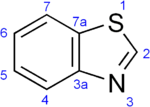Chemistry:Benzothiazole

| |||
|
| |||
| Names | |||
|---|---|---|---|
| Preferred IUPAC name
1,3-Benzothiazole | |||
| Identifiers | |||
3D model (JSmol)
|
|||
| ChEBI | |||
| ChEMBL | |||
| ChemSpider | |||
PubChem CID
|
|||
| UNII | |||
| |||
| |||
| Properties | |||
| C7H5NS | |||
| Molar mass | 135.1863 g/mol | ||
| Density | 1.238 g/mL | ||
| Melting point | 2 °C (36 °F; 275 K) | ||
| Boiling point | 227 to 228 °C (441 to 442 °F; 500 to 501 K) | ||
Except where otherwise noted, data are given for materials in their standard state (at 25 °C [77 °F], 100 kPa). | |||
| Infobox references | |||
Benzothiazole is an aromatic heterocyclic compound with the chemical formula C7H5NS. It is colorless, slightly viscous liquid. Although the parent compound, benzothiazole is not widely used, many of its derivatives are found in commercial products or in nature. Firefly luciferin can be considered a derivative of benzothiazole.
Structure and preparation
Benzothiazoles consist of a 5-membered 1,3-thiazole ring fused to a benzene ring. The nine atoms of the bicycle and the attached substituents are coplanar.
Benzothiazoles are prepared by treatment of 2-mercaptoaniline with acid chlorides:[1]
- C6H4(NH2)SH + RC(O)Cl → C6H4(NH)SCR + HCl + H2O
Uses
Benzothiazole occurs naturally in some foods but is also used as a food additive.[2] It has a sulfurous odor and meaty flavor.[3] The European Food Safety Authority assessment had "no safety concern at estimated levels of intake as a flavouring substance".[4]
The heterocyclic core of the molecule is readily substituted at the unique methyne centre in the thiazole ring. It is a thermally stable electron-withdrawing moiety with numerous applications in dyes such as thioflavin.[5] Some drugs contain this group, examples being riluzole and pramipexole. Accelerators for the sulfur vulcanization of rubber are based on 2-mercaptobenzothiazoles.[6] This ring is a potential component in nonlinear optics (NLO).[7] A benzothiazole derivative is suggested as a dye for arsenic detection.[8]
See also
- Benzothiazoles are related to thiazoles, which lack the fused benzene ring.
- Benzoxazoles, which substitute an oxygen for the sulfur atom.
References
- ↑ T. E. Gilchrist "Heterocyclic Chemistry" 3rd Edition, Longman, 1992.
- ↑ Lucille Le Bozec, Christopher J. Moody "Naturally Occurring Nitrogen–Sulfur Compounds. The Benzothiazole Alkaloids" Australian Journal of Chemistry 62(7) 639–647.doi:10.1071/CH09126
- ↑ "Benzothiazole". http://www.thegoodscentscompany.com/data/rw1007521.html.
- ↑ "Flavouring Group Evaluation 76, (FGE.76) - Consideration of sulphur-containing heterocyclic compounds evaluated by JECFA (59th meeting) structurally related to thiazoles, thiophene, thiazoline and thienyl derivatives from chemical group 29, miscellaneous". EFSA Journal 6 (11): 875. 2008. doi:10.2903/j.efsa.2008.875.
- ↑ Gill, Rupinder K.; Rawal, Ravindra K.; Bariwal, Jitender (2015). "Recent Advances in the Chemistry and Biology of Benzothiazoles". Archiv der Pharmazie 348 (3): 155–178. doi:10.1002/ardp.201400340. PMID 25682746.
- ↑ Engels, H.-W., Weidenhaupt, H.-J., Pieroth, M., et al. "Rubber, 4. Chemicals and Additives" in Ullmann's Encyclopedia of Industrial Chemistry 2004, Wiley-VCH, Weinheim. doi:10.1002/14356007.a23_365.pub2
- ↑ Hrobarik, P.; Sigmundova, I.; Zahradnik, P. et al. (2010). "Molecular Engineering of Benzothiazolium Salts with Large Quadratic Hyperpolarizabilities: Can Auxiliary Electron-Withdrawing Groups Enhance Nonlinear Optical Responses?". Journal of Physical Chemistry C 114 (50): 22289–22302. doi:10.1021/jp108623d.
- ↑ Chauhan, Kalpana; Singh, Prem; Kumari, Bhawana; Singhal, Rakesh Kumar (2017-03-16). "Synthesis of new benzothiazole Schiff base as selective and sensitive colorimetric sensor for arsenic on-site detection at ppb level" (in en). Analytical Methods 9 (11): 1779–1785. doi:10.1039/C6AY03302D. ISSN 1759-9679. https://pubs.rsc.org/en/content/articlelanding/2017/ay/c6ay03302d.
External links
 |



